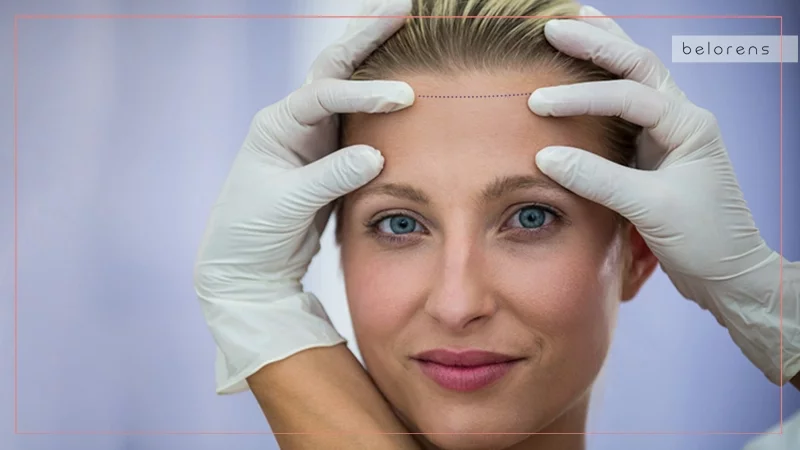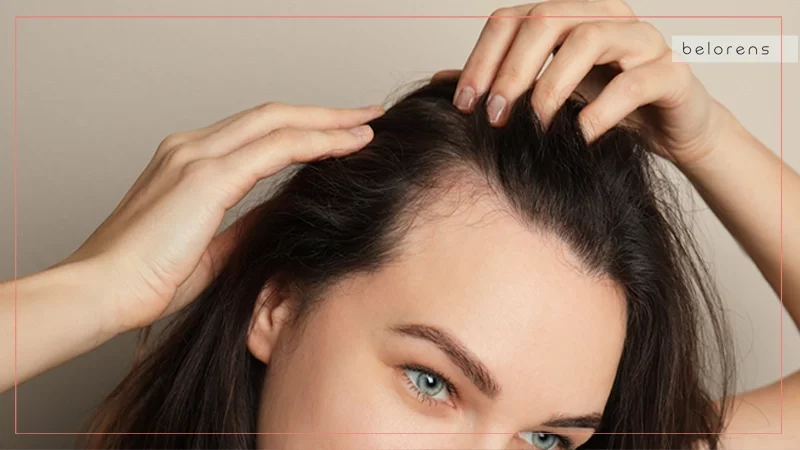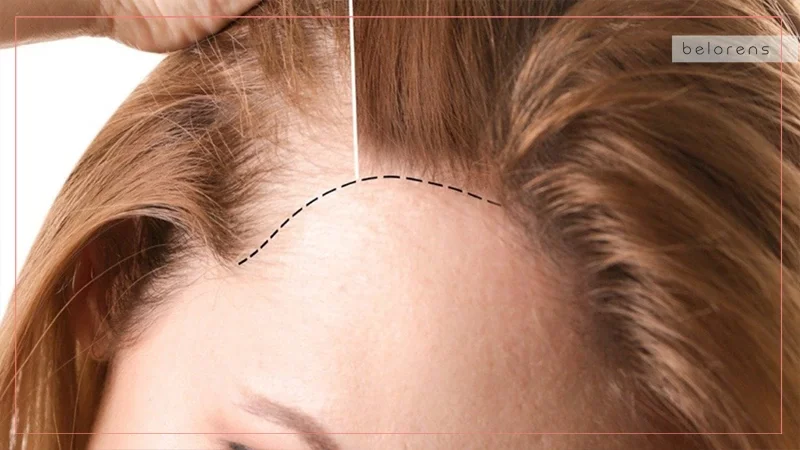Published on yesterday
Hairline Lowering with Scalp Advancement: A Comprehensive Guide
- ByMedical Content Team
- Medically Reviewed byDr. Sabine Kulhanek
Fact checked

Are you self-conscious about a high forehead or a receding hairline? You're not alone. Our hairline shapes our facial profile and can have a profound impact on our overall appearance and self-esteem. Many individuals seek solutions to enhance their hairline and achieve a more balanced facial appearance. One effective and increasingly popular procedure is hairline lowering with scalp advancement. This surgical technique offers a permanent solution for those looking to lower their hairline and improve their overall facial aesthetics.
In this blog post, we'll explore the intricacies of surgical hairline lowering, from what the procedure entails to the potential benefits and considerations. Whether you're contemplating this surgery or simply curious about cosmetic advancements, read on to discover how hairline lowering with scalp advancement can transform your look and boost your confidence.
What is hairline lowering with scalp advancement?
Surgical hairline advancement, also known as hairline lowering or forehead reduction, is a cosmetic procedure designed to decrease the height of the forehead and bring the hairline closer to the brows using the scalp advancement technique.
Scalp advancement is a commonly used technique for hairline lowering besides hair transplantation. This procedure can significantly enhance the appearance of an individual with a natural high forehead, or otherwise a high forehead caused by a receding hairline.
Who are good candidates?
Forehead reduction or hairline lowering is best suited to individuals, typically women, with a lifelong history of a high hairline and no familial or personal history of progressive hair loss. Men and women of every race and ethnicity can have high hairlines due to various factors. Here are some aspects that may make someone a good candidate for hairline lowering with scalp advancement:
- Individuals with a high hairline or large forehead who desire a more proportionate facial appearance
- People with a stable and healthy hairline
- Non-smokers or those willing to quit smoking before and after the procedure to reduce complications and promote healing
- People who are realistic about the outcomes of this procedure
- People in good overall health and without underlying medical conditions that may affect the healing process
- People who have tried other methods to lower their hairline, such as hair transplantation or non-surgical procedures, but have not achieved the desired results
How is it done?

The hairline lowering with scalp advancement procedure is typically performed under general anesthesia and takes about one hour to complete. The process involves removing the upper part of the forehead skin that does not contain hair and shifting the scalp forward to replace the hairless area with one that contains hair. This effectively lowers the scalp and reduces the forehead's height. Unlike hair transplantation, there is no need for a hair donor area.
To reduce the forehead's height, the scalp advancement flap technique is preferred. The procedure begins with an incision at the junction between the hair and forehead to minimize the visible scar. Next, the surgeon removes 2 to 3 cm of the forehead skin and closes the incision by moving the hairline downward, which reduces the forehead's height by 2 to 3 cm. Finally, a compression bandage is placed for 24 hours and removed the day after the operation.
Also Read: Comparison of FUT and FUE: Two Common Hair Transplant Methods
What's the recovery like?
Recovery after forehead reduction with scalp advancement usually takes one to two weeks. Patients may experience mild pain, swelling, and bruising in the treated area, which typically subside after a few days. Patients should avoid vigorous activities, heavy lifting, and bending over for at least two weeks after the surgery. The sutures are usually removed within ten to fourteen days after the procedure. Patients should also avoid exposing the treated area to direct sunlight for several weeks after the surgery.
After surgical forehead reduction, patients should meticulously follow their surgeon's aftercare instructions. This may include taking pain medications, applying cold compresses to the treated area, and using a medicated shampoo to clean the scalp. Patients should avoid using hair dryers, straighteners, or other hair styling products for at least two weeks after the surgery. The results of hairline lowering with scalp advancement are permanent, allowing patients to enjoy a lower hairline that enhances their facial appearance.
Also Read: Hair Transplant Recovery Guide
What are the side effects and risks?

Like any surgical procedure, hairline lowering with scalp advancement carries some risks and potential side effects. However, most patients experience minimal complications and are pleased with the results of the procedure. Here are some of the risks and side effects that may be associated with hairline lowering with scalp advancement:
- Infection: Infection is a rare but potential risk of any surgical procedure. To reduce the risk of infection, patients will be prescribed antibiotics to take before and after the surgery.
- Bleeding: Some bleeding is common during and after the surgery, but excessive bleeding is rare. Patients may experience mild swelling and bruising after the procedure, which should recede within a few days.
- Scarring: While the incision made during the surgery is generally small and hidden by the hairline, there is still a risk of scarring. Most scars will fade over time and can be further minimized by proper post-operative care.
- Hair loss: In rare cases, hair loss can occur around the incision site. This is typically temporary and will improve over time.
- Nerve damage: There is a minor risk of nerve damage during the procedure, leading to numbness or tingling around the forehead and scalp.
- Asymmetry: In some cases, the surgery results may not be perfectly symmetrical. This can be corrected with a touch-up procedure or other corrective measures.
Choosing a qualified and experienced plastic surgeon specializing in hairline lowering with scalp advancement is crucial to minimize these risks and side effects. Patients should also follow all pre-operative and post-operative instructions to ensure a successful and safe recovery. If any complications arise, patients should contact their surgeons immediately for guidance and treatment.
Cost
The cost of hairline lowering with scalp advancement typically ranges from $5,000 to $10,000. However, this cost may or may not include additional fees such as anesthesia and facility fees. The extent of the surgery is a significant factor influencing the cost of hairline lowering with scalp advancement. For instance, individuals with a larger forehead may require more extensive surgery, leading to higher costs. Additionally, the surgeon's expertise and qualifications may also affect the cost of the procedure. The clinic's location is another factor that may impact the cost of the procedure. For example, clinics in metropolitan areas may charge higher fees compared to clinics in rural areas.
It is important to note that hairline lowering with scalp advancement is a cosmetic procedure, and most insurance companies do not cover cosmetic surgeries. However, patients may explore financing options such as payment plans or loans to manage the cost of the procedure. Some plastic surgery clinics also offer financing options to help patients manage the cost of the procedure.
Hairline lowering with scalp advancement vs. hair transplant

Hairline lowering with scalp advancement and hair transplantation are two distinct procedures that can address the issue of a high or receding hairline. While both procedures aim to create a more youthful and natural-looking hairline, they differ significantly in their approach, recovery time, and suitability for different individuals.
Hairline lowering with scalp advancement is a surgical procedure that involves removing a strip of skin from the forehead and moving the scalp forward. This technique is appropriate for individuals with a high hairline or large forehead, as it provides a permanent and long-lasting solution. However, it is a more invasive procedure requiring a more extended recovery period and may not be suitable for individuals with limited scalp laxity or those unwilling to undergo surgery.
On the other hand, hair transplantation is a procedure that involves transplanting hair follicles from one part of the scalp to another. It is suitable for individuals experiencing hair loss or thinning hair, and it provides natural-looking results with a shorter recovery period. However, it may not be suitable for individuals with severe hair loss or insufficient donor hair. Furthermore, the results may not be permanent, necessitating patients to undergo repeat sessions to maintain the results.
To learn more about the difference between the two procedures, read Hairline Lowering with Hair Transplant vs Scalp Advancement: Everything You Need to Know
FAQs
How long does the hairline lowering procedure take?
The hairline lowering with scalp advancement procedure typically takes about 1 to 2 hours, depending on the complexity of the case.
When can I return to work after hairline lowering surgery?
Most patients can return to work and resume light activities within a week to ten days after the surgery, provided they follow post-operative care instructions.
Will I need to stay overnight in the hospital after the procedure?
Hairline lowering with scalp advancement is usually performed on an outpatient basis, meaning you can go home the same day after a few hours of observation.
Can men undergo hairline lowering with scalp advancement?
Yes, men can undergo this procedure, but it's essential for them to have a stable hairline and no history of progressive hair loss to achieve the best results.
How noticeable will the scar be after the surgery?
The scar from hairline lowering is typically hidden along the hairline, and with proper care, it usually becomes less noticeable over time.
Are there any non-surgical alternatives to hairline lowering?
While non-surgical options like hair transplant and certain cosmetic treatments exist, they might not provide the same level of forehead reduction as scalp advancement.
Can hairline lowering with scalp advancement be combined with other facial procedures?
Yes, hairline lowering can be combined with other facial cosmetic procedures, such as brow lifts or eyelid surgery, to achieve a more comprehensive facial rejuvenation.
How soon will I see the final results of the surgery?
Initial results are visible immediately after surgery, but final results can take several months as swelling subsides and the scalp adjusts to its new position.




